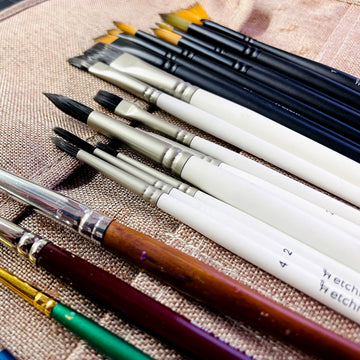
What do you look for when picking out your painting essentials? In this blog post, we’ll be taking an extra close look at paintbrush quality – what affects it and how different features affect your painting experience.
Quality vs. Price
In a previous blog post about paintbrushes, I explained the difference between synthetic and natural hair. To recap, synthetic brushes are made with synthetic bristles and tend to be cheaper than natural hair brushes made from animal hair.

While it’s easy to associate “cheap” with “cheaper quality”, it doesn’t always work out that way. There are plenty of synthetic brushes made very well and feel quite similar to natural hair bristles – which you can get without breaking the bank! Just make sure the bristles come to a fine point or edge when wet.
Another feature of the synthetic brush is that it usually has more spring than a natural hair brush. This means it snaps back to its original shape easier, which may take some getting used to, but the upside is that it’s easier to control your brushstrokes.
They’re also much more durable than natural hair brushes, making them more suitable for denser paint media like acrylic, oil, or gouache paint.
Synthetic brushes work well with watercolour paints, too, though a slight downside would be that they don’t hold as much paint in one go unless you use a large mop brush. And last but not least, they’re vegan-friendly!

For natural hair brushes, well-made ones are quite balanced – they have a little bit of spring to their bristles but are still easy to control while retaining a lot of moisture, so you don’t have to keep re-dipping into your paint well. They also come to a fine point when wet and feel very smooth to use, even for beginners.
The downside is that they’re usually much more expensive, and they’re not as durable as synthetic brushes, meaning that after a while, the bristles might not come to a fine point or edge anymore or even start shedding more often and ruining your painting experience.
They also require more aftercare, so those on a time crunch or who prefer to paint outdoors (i.e. Plein air) should pick a synthetic brush instead.
Last but not least, natural brushes are best suited for watercolours and gouache, as paints like acrylics will ruin the bristles.
In general, good quality brushes will:
-
Have bristles that come to a fine point or edge
-
Be reasonably durable
-
Not lose hair while painting (at least not often!)
-
Not have the handle coating flake off after a few washes
-
Be versatile and usable in most situations. Sometimes, one good paintbrush of the right shape and size is all you need!
-
Feel good to use
The best way to find out a brush’s quality is to try it. Does it feel easy to control? Does it shed while painting? Can you paint thin lines, even with a larger brush size? Does it feel pleasant to use – then the brush works for you, not the other way round?
It may take a little trial and error or even some research to find what works for you, especially if you’re working on a tight budget.
Spot the Difference

I used two different size 12 round brushes to paint the same watercolour painting in the image above. Same paints and colours, too. Can you tell which one was done with the better-quality paintbrush?
With the painting on the right, you can tell that the brush doesn’t come to a fine point anymore because the ends of the girl’s hair and the animal’s fur aren’t thin enough.
And though I did try my best to paint with the same proficiency for both paintings, using the low-quality brush was just a miserable experience, which you might be able to tell from the girl’s hair (which at some point I gave up on trying to fix).
With the one on the left, it was a much smoother experience, which you can tell from the smoother blends I could get in the cheeks and shirt. And the hair and fur textures are much more refined, even when I was using such a large paintbrush!
Final Thoughts

If you’re still on the hunt for a solid set of paintbrushes, try Etchr’s set of 10 watercolour brushes! Though they are labelled for watercolour, you can just as easily use them for other media like acrylics and gouache paint, as the thicker synthetic bristles make them work well with these media too.
They also come to a sharp point and have a good spring to them, making them durable and easier to control. If your budget is really tight, you could even share with a fellow watercolourist (5 paintbrushes each is more than enough to paint what you need! Though you might have to flip a coin for the nifty roll-up pouch).
Whatever paintbrush you decide to get, I’ve given you an essential checklist of what to look out for and what to avoid. Hopefully, it will help you in your future purchases as well! And keep creating, as the final test any paintbrush has to pass is the test of time.
What’s your favourite paintbrush to use? Have you experienced the difference in paintbrush quality yourself in the past? Feel free to share with us in the comments below!



2 comments
I agree with the comment above, the one on the right is the smoother painting. In my opinion anyway.
Thanks for a great article!
I think you made an editing error. The painting on the right looks the best, not the worst. The painting on the left is the worst.